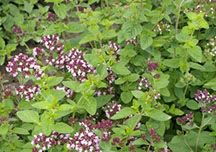
Other articles you might enjoy:
1. Elegant Eggplant Steals the Show
3. Garlic Questions and Answers Page
Make the most of culinary herbs and spices.
All About Oregano
by Sandra Bowens
photo courtesy of the National Garden Bureau

Botanically speaking, oregano and marjoram will make you nuts. Although they are different in flavor and appearance, they are known by the same name. For years both plants were referred to as Origanum majorana. Botanists now identify oregano and marjoram as Majorana hortensis, but are quick to point out that this name really belongs to the "sweet" marjoram of the Mediterranean.
Cooks are quick to point out that no matter what the botanists say, the two herbs are not the same. Nor are the two varieties of oregano, Greek and Mexican, the same. Botanists do abide by using the names O. graveolens for the Mexican type and Origanum vulgare. for the Mediterranean type.
Confused enough? Read All About Marjoram later and let's concentrate on oregano for now.
Oregano derives its name from two Greek words meaning "the joy of the mountain." It is a hardy member of the mint family that has been used for flavoring fish, meat and sauces since ancient times. It was long referred to as wild marjoram.
The pungent herb gained great popularity in the United States after 1940 when returning G.I.'s longed for the flavor of pizza they had sampled in Italy. Oregano is often referred to as the "pizza herb." It's a natural for all types of tomato sauces but also goes well with egg and cheese dishes. Oregano and basil combine to create a special flavor common in the Italian cooking we know so well.
Greek oregano is as essential to pizza as Mexican oregano is to chili powder. You may use the two types interchangeably but using one specifically increases the authenticity of certain dishes. Mexican oregano has a more earthy flavor with less hint of mint in the aroma. Use it for your Mexican cooking. Set them side by side and you will quickly see the difference. Mexican oregano has an abundance of what appear to be tiny flower buds and leaves while Greek oregano has a more cut-leaf appearance.
Turkey and Greece are the principal suppliers of Greek oregano. Mexican oregano, naturally, hails from Mexico. Aside from just tomato dishes, use oregano in vegetable or bean dishes or try fresh leaves tossed into your next salad. Add a bit of Mexican oregano to barbecue sauce or meatloaf for a change of pace.
Anytime Pizza
Sometimes the urge for pizza just won't wait thirty minutes. Keep a few key ingredients on hand and use your imagination to satisfy that craving at a moment's notice. You'll need a crust, a sauce, cheese and toppings. Look in the refrigerator and be creative!
The crust can be any bread product from a prepared pizza crust (like Boboli) to a slice of French bread. Think, too, of bagels, tortillas, English muffins or biscuits. The new supermarket bakery specialty breads are especially good.
For a simple sauce, add 3/4 teaspoon dried oregano, 1/4 teaspoon dried basil, a few pinches dried thyme and a bit of crushed red peppers, if desired, into an 8-ounce can of tomato sauce. Just mix the herbs right in the can for easy clean up.
Cheese and toppings can be any that are available. Mix bits of cheese together for unique combinations. Don't forget that jar of capers in the back of the refrigerator or those handy bacon bits you put on your salad.
Build your pizza and pop it into a preheated 450 degree oven until the cheese melts. Now you can satisfy that craving without waiting for the doorbell.
Here's one that's full of our favorite recipes because we wrote the book! It is also full of information, helpful hints and ideas for using herbs and spices in your kitchen.
Does garlic really repel vampires and cure the hiccups? Find answers to these questions and way more than you ever thought possible about the stinking rose.
Rosalind Creasy knows all about using food plants to round out your yard. She pioneered the idea 25 years ago. This updated edition includes 300 inspiring photographs.
Much different than the typical Junior League collection, this award-winning book from the Houston club covers far more than rosemary.





